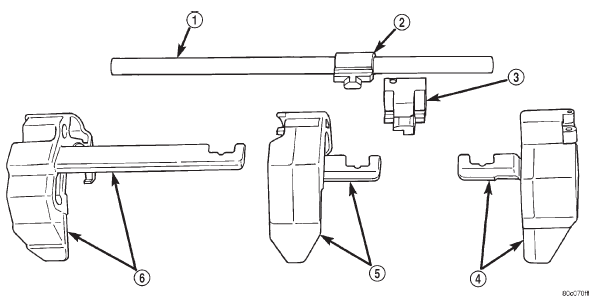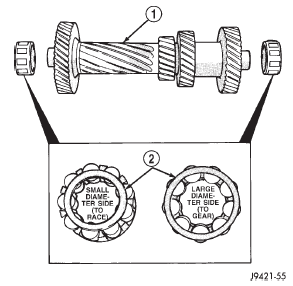Jeep Cherokee (XJ): Cleaning and inspection
TRANSMISSION COMPONENTS
Clean the gears, shafts, shift components and transmission housings with a standard parts cleaning solvent. Do not use acid or corrosive base solvents.
Dry all parts except bearings with compressed air.
Clean the shaft bearings with a mild solvent such as Mopart degreasing solvent, Gunk, or similar solvents.
Do not dry the bearings with compressed air.
Allow the bearings to either air dry, or wipe them dry with clean shop towels.
SHIFT LEVER ASSEMBLY
The shift lever assembly is not serviceable. Replace the lever and shift tower as an assembly if the tower, lever, lever ball, or internal components are worn, or damaged.
SHIFT SHAFT AND FORKS
Inspect the shift fork interlock arms and synchro sleeve contact surfaces (Fig. 134). Replace any fork exhibiting wear or damage in these areas. Do not attempt to salvage shift forks.
Check condition of the shift shaft detent plunger and spring. The plunger should be smooth and free of nicks, or scores. The plunger spring should be straight and not collapsed, or distorted. Minor scratches, or nicks on the plunger can be smoothed with 320/400 grit emery soaked in oil. Replace the plunger and spring if in doubt about condition. Check condition of detent plunger bushings. Replace if damaged.
Inspect the shift shaft, shift shaft bushing and bearing, the shaft lever, and the lever bushing that fits over the lever. Replace the shaft if bent, cracked, or severely scored. Minor burrs, nicks, or scratches can be smoothed off with 320/400 grit emery cloth followed by polishing with crocus cloth. Replace the shift shaft bushing or bearing if damaged.
Replace the shaft lever and bushing if either part is deformed, or worn. Do not attempt to salvage these parts as shift fork binding will occur. Replace the roll pin that secures the lever to the shaft.
FRONT/REAR HOUSINGS AND BEARING RETAINERS
Inspect the housings carefully. Look for cracks, stripped threads, scored mating surfaces, damaged bearing bores, or worn dowel pin holes. Minor nicks on mating surfaces can be dressed off with a fine file, or emery cloth. Damaged threads can be renewed by either re-tapping or installing Helicoil inserts.

Fig. 134 Shift Forks And Shaft
1 - SHIFT SHAFT
2 - SHAFT LEVER
3 - SHAFT LEVER BUSHING
4 - 3-4 SHIFT FORK
5 - 1-2 SHIFT FORK
6 - FIFTH-REVERSE SHIFT FORK
NOTE: The front housing contains the countershaft front bearing race. The rear housing contains the countershaft rear bearing race. Be advised that these components are NOT serviceable items. The front housing will have to be replaced if the countershaft bearing race is loose, worn, or damaged.
The rear housing will have to be replaced if the countershaft rear bearing race is loose, worn, or damaged.
Inspect the input shaft bearing retainer. Be sure the release bearing slide surface of the retainer is in good condition. Minor nicks on the surface can be smoothed off with 320/420 grit emery cloth and final polished with oil coated crocus cloth. Replace the retainer seal if necessary.
Inspect the output shaft bearing retainer. Be sure the U-shaped retainer is flat and free of distortion.
Replace the retainer if the threads are damaged, or if the retainer is bent, or cracked.
COUNTERSHAFT BEARINGS AND RACES
The countershaft bearings and races are machine lapped during manufacture to form matched sets.
The bearings and races should not be interchanged.
NOTE: The bearing races are a permanent press fit in the housings and are NOT serviceable. If a bearing race becomes damaged, it will be necessary to replace the front or rear housing as necessary. A new countershaft bearing will be supplied with each new housing for service use.
The countershaft bearings can be installed backwards if care is not exercised. The bearing roller cage is a different diameter on each side. Be sure the bearing is installed so the large diameter side of the cage is facing the countershaft gear (Fig. 135). The small diameter side goes in the bearing race.
REVERSE IDLER COMPONENTS
Inspect the idler gear, bearing, shaft, thrust washer, wave washer and thrust plate. Replace the bearing if any of the needle bearing rollers are worn, chipped, cracked, flat-spotted, or brinnelled. Also replace the bearing if the plastic bearing cage is damaged or distorted.
Replace the thrust washer, wave washer, or thrust plate if cracked, chipped, or worn. Replace the idler gear if the teeth are chipped, cracked or worn thin.
Replace the shaft if worn, scored, or the bolt threads are damaged beyond repair. Replace the support segment if cracked, or chipped and replace the idler attaching bolts if the threads are damaged.

Fig. 135 Correct Countershaft Bearing Installation
1 - COUNTERSHAFT
2 - BEARING CAGE
Shift Socket
Inspect the shift socket for wear or damage.
replace the socket if the roll pin, or shift shaft bores are damaged. Minor nicks in the shift lever ball seat in the socket can be smoothed down with 400 grit emery or wet/dry paper. Replace the socket if the ball seat is worn, or cracked. Do not reuse the original shift socket roll pin. Install a new pin during reassembly.
The socket roll pin is approximately is approximately 33 mm (1-1/4 in.) long.
Output Shaft And Geartrain
Inspect all of the gears for worn, cracked, chipped, or broken teeth. Also check condition of the bearing bore in each gear. The bores should be smooth and free of surface damage. Discoloration of the gear bores is a normal occurrence and is not a reason for replacement. Replace gears only when tooth damage has occurred, or if the bores are brinnelled or severely scored.
Inspect the shaft splines and bearings surfaces.
Minor nicks on the bearing surfaces can be smoothed with 320/420 grit emery and final polished with crocus cloth. Replace the shaft if the splines are damaged or bearing surfaces are deeply scored, worn, or brinnelled.
 Diagnosis and testing. Removal and installation. Disassembly and assembly
Diagnosis and testing. Removal and installation. Disassembly and assembly
Other materials:
Removal and installation
Door module
(1) Disconnect and isolate the battery negative
cable.
(2) Remove the screws that secure the front door
trim panel to the inner door panel (Fig. 4).
(3) Using a trim stick or another suitable wide
flat-bladed tool, gently pry the front door trim panel
away from the door around ...

